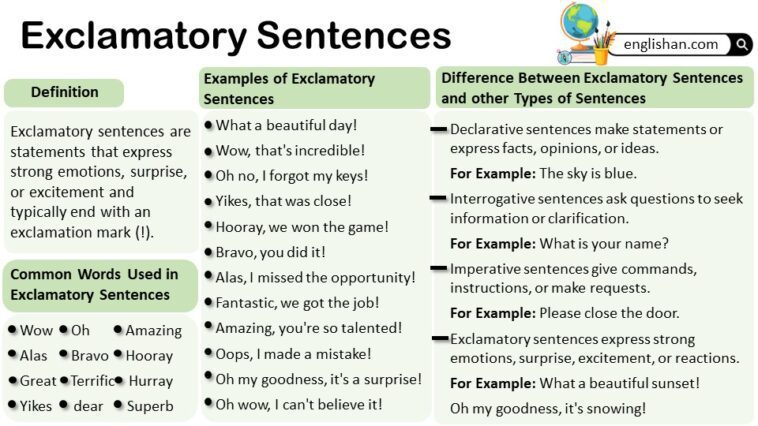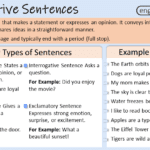Exclamatory sentences are sentences that express strong emotions, excitement, surprise, or strong feelings. They often end with an exclamation mark (!) to convey the emotional tone. Exclamatory sentences can cover a wide range of emotions, including joy, anger, surprise, admiration, or frustration.
What Is An Exclamatory Sentence?
An exclamatory sentence is a type of sentence that conveys strong emotions, excitement, surprise, or intense feelings. These sentences are characterized by their exclamation mark (!) at the end, which serves to emphasize the emotional tone. Exclamatory sentences can express a wide range of emotions, including joy, anger, surprise, admiration, or frustration.
Here are some key features of exclamatory sentences:
1. Expressive Tone: Exclamatory sentences are used to convey strong emotions or reactions.
2. Exclamation Mark: The presence of an exclamation mark is a defining characteristic. It signifies the emotional intensity of the statement.
3. Word Order: The word order in an exclamatory sentence may be similar to that of a declarative sentence (subject-verb-object), but it is the overall context and the exclamation mark that make it exclamatory.
Examples of Exclamatory Sentences
Exclamatory sentences express strong emotions or feelings. They often end with an exclamation mark. Here are some examples:
- What a beautiful day it is!
- I can’t believe it—amazing!
- How wonderful the party was!
- Wow, that’s impressive!
- What a surprise to see you!
- Oh no, I forgot my keys!
- How cool is that gadget!
- Yikes, it’s raining!
- What a fantastic idea for a game!
- Bravo, you did it!
- How tasty the pizza is!
- Oh dear, I missed the bus!
- What a great movie we watched!
- Hooray, we won the game!
- How cute the puppy is!
- Oops, I dropped my phone!
- What a lovely surprise party!
- Wow, look at that sunset!
- How exciting this news is!
- Oh my goodness, it’s snowing!
- What a fantastic day at the beach!
- Yippee, it’s my birthday!
- How amazing your artwork is!
- Oh wow, I can’t believe it!
- What a great time we had together!
Exclamatory Sentences Starting with “What” and “How”?
Starting with “What”:
- What a magnificent sunset that is!
- What an interesting book you recommended!
- What a surprise party they organized for her!
- What a delicious aroma is coming from the kitchen!
- What an amazing performance by the orchestra!
- What a beautiful painting you created!
- What a fantastic idea for the school project!
- What a wonderful gift you gave me!
- What a fantastic vacation destination they chose!
- What a great accomplishment you’ve achieved!
Starting with “How”:
- How thrilling the roller coaster ride was!
- How wonderful it is to see you after so long!
- How beautiful the flowers look in the garden!
- How surprised I am to find you here!
- How delicious this chocolate cake tastes!
- How fantastic the weather is today!
- How amazing your performance was on stage!
- How great it feels to achieve our goals!
- How lovely the garden looks in spring!
- How incredible the fireworks display is!
Here’s a breakdown of the structure and punctuation:
Structure:
1. Interjection or Subject (optional): Exclamatory sentences often begin with an interjection (a word expressing strong emotion) or a subject, which is the person, thing, or idea the sentence is about.
2. Verb: The verb follows the interjection or subject and conveys the action or state of being.
3. Object (optional): An object, representing the recipient of the action, may follow the verb.
Punctuation:
- The key punctuation mark for an exclamatory sentence is the exclamation mark (!), which is placed at the end of the sentence to convey strong emotion or emphasis.
Here’s an example to illustrate:
What a beautiful sunset!
- Interjection: What
- Verb: beautiful
- Object: sunset
- Punctuation: Exclamation mark at the end for emphasis.
How amazing your performance is!
- Interjection: How
- Verb: amazing
- Object: your performance
- Punctuation: Exclamation mark at the end for emphasis.
How incredible the fireworks display was!
- Interjection: How
- Verb: incredible
- Object: the fireworks display
- Punctuation: Exclamation mark for emphasis.
What a surprise to find you here!
- Interjection: What
- Verb: a surprise
- Object: to find you here
- Punctuation: Exclamation mark for emphasis.
Wow, that’s an impressive magic trick!
- Interjection: Wow
- Verb: that’s impressive
- Punctuation: Exclamation mark for emphasis.
How beautiful the autumn leaves look!
- Interjection: How
- Verb: beautiful
- Object: the autumn leaves
- Punctuation: Exclamation mark for emphasis.
What a fantastic job you did on the presentation!
- Interjection: What
- Verb: a fantastic job
- Object: on the presentation
- Punctuation: Exclamation mark for emphasis.
What an adorable puppy!
- Interjection: What
- Verb: an adorable
- Object: puppy
- Punctuation: Exclamation mark for emphasis.
Common Words Used in Exclamatory Sentences
Exclamatory sentences often include words and phrases that express strong emotions, enthusiasm, or surprise.
Here are some common words and expressions used in:
- What: What a beautiful day!
- How: How amazing that performance was!
- Wow: Wow, that’s incredible!
- Oh: Oh no, I forgot my keys!
- Yikes: Yikes, that was close!
- Hooray: Hooray, we won the game!
- Bravo: Bravo, you did it!
- Alas: Alas, I missed the opportunity!
- Fantastic: Fantastic, we got the job!
- Amazing: Amazing, you’re so talented!
- Oops: Oops, I made a mistake!
- Oh my goodness: Oh my goodness, it’s a surprise!
- Phew: Phew, that was a relief!
- No way: No way, I can’t believe it!
- Unbelievable: Unbelievable, what a story!
Points to Remember When Using Exclamatory Sentences
When using exclamatory sentences, there are several points to keep in mind to effectively convey strong emotions or excitement. Here are some key points to remember
1. End with an Exclamation Mark (!): Always conclude exclamatory sentences with an exclamation mark to clearly signal the heightened emotional tone.
2. Express Emotion Clearly: Use to express strong emotions, excitement, surprise, or enthusiasm. Be clear and direct in conveying the intended emotion.
3. Begin with Interjections or Adverbs: Start with interjections (e.g., What, Oh, Wow) or adverbs (e.g., How) to establish the emotional context right from the beginning.
4. Vary Sentence Structure: Create variety in sentence structure to maintain reader engagement. Combine simple and complex sentences for a more dynamic and natural flow.
5. Choose Descriptive Words: Enhance the impact of exclamatory sentences by using descriptive and vivid language. Paint a clear picture of the emotions or experiences you are expressing.
6. Avoid Overuse of Exclamation Marks: While exclamation marks emphasize excitement, avoid overusing them, as this can diminish their effectiveness. Use them judiciously for maximum impact.
7. Consider Context and Audience: Assess the appropriateness of exclamatory sentences based on the context and audience. In formal writing, use them sparingly, and adjust your tone to match the situation.
8. Ensure Clarity: Ensure that your exclamatory sentences are clear and unambiguous. Ambiguity can lead to confusion about the intended emotion or message.
9. Maintain Consistent Tone: Ensure that the tone of your exclamatory sentences aligns with the overall tone of your message or conversation. Consistency helps convey a coherent emotional message.
10. Practice Readability: Prioritize readability by using concise and well-structured sentences. Aim for clarity without sacrificing the impact of the exclamation.
How to Use Exclamatory Sentences Effectively
Using exclamatory sentences effectively involves employing them strategically to convey strong emotions, excitement, or emphasis. Here are some tips on how to use exclamatory sentences effectively:
1. Identify Key Emotions: Determine the primary emotion or emphasis you want to convey. Exclamatory sentences are great for expressing joy, surprise, enthusiasm, admiration, or frustration.
2. Begin with Interjections or Adverbs: Start the sentence with interjections like “What,” “How,” or adverbs that express emotion. This immediately sets the tone for excitement or emphasis.
- Example: Wow, that’s incredible!
3. Use Vivid Descriptions: Enhance the impact of it by incorporating descriptive and vivid language. Paint a clear picture to evoke a stronger emotional response.
- Example: What a stunning sunset over the ocean!
4. Consider Sentence Structure: Experiment with different sentence structures to keep your writing engaging. Combine simple and complex sentences to create a natural flow.
- Example: How amazing it is to witness such natural beauty!
5. Match the Tone to the Situation: Be mindful of the context and adjust the tone of your exclamatory sentences accordingly. Consider the formality of the situation and the expectations of your audience.
- Example: Oh no, I can’t believe I made that mistake!
6. Avoid Overusing Exclamation Marks: While exclamation marks are essential be cautious not to overuse them. Reserve them for instances where you want to convey strong emotions.
- Example: Hooray, we won the game!
7. Use for Emphasis: Employ exclamatory sentences to emphasize a particular point, creating a memorable impact on the reader or listener.
- Example: What an incredible journey this has been!
8. Express Genuine Emotion: These are most effective when the emotion expressed is genuine. Authenticity enhances the impact and resonates with your audience.
- Example: How wonderful it is to see you after so long!
Quiz:
1. Which of the following is an exclamatory sentence?
- A) The sun rises in the east.
- B) What a beautiful sunrise!
2. What punctuation mark typically ends an exclamatory sentence?
- A) Period
- B) Exclamation mark
3. Identify the exclamatory sentence:
- A) Please pass the salt.
- B) Wow, what a fantastic view!
4. Which option represents an exclamatory sentence?
- A) The cat is sleeping.
- B) How amazing is this performance!
5. What is a key characteristic of exclamatory sentences?
- A) Making statements
- B) Expressing strong emotions
6. Choose the exclamatory sentence:
- A) Be careful with that!
- B) My dog is so cute.
7. Which of the following is an exclamatory sentence about the weather?
- A) What time is it?
- B) It’s so hot today!
8. Identify the exclamatory sentence:
- A) Read this book.
- B) How incredible is this story!
9. What is the main purpose of exclamatory sentences?
- A) Asking questions
- B) Expressing strong emotions
10. Select the exclamatory sentence:
- A) Stop talking!
- B) The sun sets in the west.
Answers:
- B) What a beautiful sunrise!
- B) Exclamation mark
- B) Wow, what a fantastic view!
- B) How amazing is this performance!
- B) Expressing strong emotions
- A) Be careful with that!
- B) It’s so hot today!
- B) How incredible is this story!
- B) Expressing strong emotions
- B) The sun sets in the west.
FAQS:
1. What is an exclamatory sentence?
It is a type of sentence that expresses strong emotions, excitement, surprise, or enthusiasm. It often ends with an exclamation mark.
2. What is the typical structure of an exclamatory sentence?
It can have various structures, but it typically includes a subject, a verb, and an exclamation at the end to convey strong emotion.
3. What is the function of an exclamatory sentence?
The primary function is to convey heightened emotions or make emphatic statements.
4. What punctuation mark is used at the end of an exclamatory sentence?
It ends with an exclamation mark (!) to indicate the strong emotion or emphasis.
5. Can an exclamatory sentence be a question?
While interrogative sentences (questions) are distinct, sometimes they may convey a sense of surprise or disbelief, similar to a question.
6. Are there specific words that make a sentence exclamatory?
Certain words or phrases, such as “What,” “How,” or interjections like “Wow” and “Oh,” are often used in it to express strong emotion.
7. How does the tone of exclamatory sentences differ from other sentence types?
amatory sentences have a more enthusiastic and emotional tone compared to declarative, interrogative, or imperative.
8. Can exclamatory sentences be used in formal writing?
While we are commonly used in informal or expressive writing, they can be used in formal writing when appropriate to convey emphasis or excitement.
You May Also Like:




